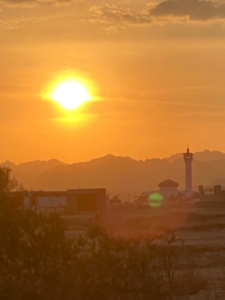New England Forestry Foundation (NEFF) Deputy Director and Climate Fellow Andi Colnes live-blogged from United Nations climate-change conference COP27 in Egypt from Nov. 14-17, and has now written a final wrap-up post during one of the several flights that brought her home.
Writing by Andrea Colnes
Globally, in session after session and COP after COP, participants are consistent in what they say it will take to realize the climate benefits of forests: financing and capacity building. These two things surface from forestry experts, forest landowners, and policy makers in Ghana, Peru, Nepal, Indonesia… and yes, here at home in the hills of New England. What does this mean for our work at New England Forestry Foundation (NEFF) and how does the global conversation inform, challenge, or support our approach?
The good news is NEFF’s programs are is focused on exactly these two arenas.
How Does NEFF Build Capacity to Address the Climate Crisis?
- Through defining Exemplary Forestry standards, demonstrating those standards through harvests on our own lands, conducting outreach and trainings for foresters and loggers, developing forest management plans for smaller forest landowners, and conducting cutting-edge research on our 30 Percent Solution;
- By supporting essential research and modeling through the Forest Carbon for Commercial Landowner (FCCL) process, and partnering with the Harvard Forest and Highstead Foundation on their 2022 report, “New England’s Climate Imperative: Our Forests as a Natural Climate Solution,” an analysis of the carbon removal potential of our forests;
- By supporting mass timber construction while developing climate-smart wood sourcing criteria.
All this is essential capacity-building and exactly the right direction for NEFF to pursue as we look toward the years ahead.
Financing
NEFF has long understood the critical importance of finding ways to help forest landowners manage the costs associated with implementing climate-smart forestry. To this end:
- NEFF launched the Pooled Timber Income Fund and the Exemplary Forestry Investment Fund (via the Maine Mountains Collaborative).
- We have the unprecedented opportunity to work with partners to pilot climate-smart forestry across the region via our $30 million USDA Climate-Smart Commodities program.
As I noted in an earlier blog from COP, NEFF will work hard to use this program to prove the market and develop scalable approaches through the new $27 billion Greenhouse Gas (GHG) Reduction Fund created by the Inflation Reduction Act to provide low interest loans to New England landowners to implement climate-smart forestry and develop financing models that could be replicated at scale across the region and country.
Takeaways

Sunset over COP27, photo by Andi Colnes
So, what did we learn? What value can NEFF make of having spent time and GHG emissions to get to this COP? As it was a first for us, it was an exploratory mission, and the lessons and opportunities are big picture. Here are a few that stand out
Verifying Carbon Benefits: There are many countries and organizations working on how to achieve, monitor and verify the carbon benefits of forests. Through REDD+ (Reducing Emissions From Deforestation and Forest Degradation in Developing Countries), global standards for forest carbon including additionality and leakage have been developed, and NEFF can benefit from considering these as we develop our own carbon monitoring processes for work under our USDA Climate-Smart Commodities program.
Finance: Financing improved forest management is a clear global priority and “public-private partnerships” and “blended structures” are the buzz words of the moment. But, applying finance to the longer timeframe for forest management (vs. agriculture) is still a gleam in the eye. At session after session, I listened for detail on how folks were actually doing this on the ground, but alas, it was not yet specific and applied. So, I learned that while a global interest in this space exists, no one has yet figured it out. Indeed, what NEFF develops as part of our own efforts to finance Exemplary Forestry will be important not only to New England, but to countries working towards climate goals around the world.
Meanwhile, I can almost feel the home fires burning now that I’m heading back across the Atlantic… flying from South Sinai into the first snows of our New England winter. The waters of the Red Sea felt lovely on my feet yesterday, but the call of home is stronger. I guess I’ve always preferred wool to sunscreen!
Related Posts
New England Forestry Foundation Heads To COP27 | November 10
NEFF at COP27: Day 1 | November 14
NEFF at COP27: Day 2 | November 15
NEFF at COP27: Day 3 | November 16
NEFF at COP27: Day 4 | November 17
COP27 Wrap Up—What Did We Learn, What Did We Share? | November 21
